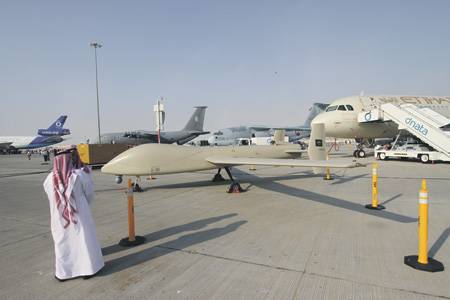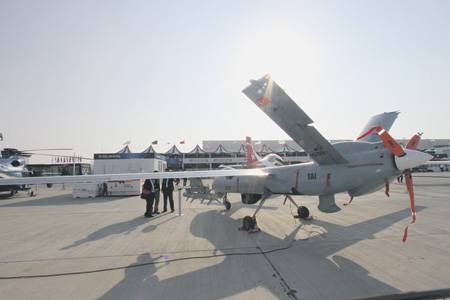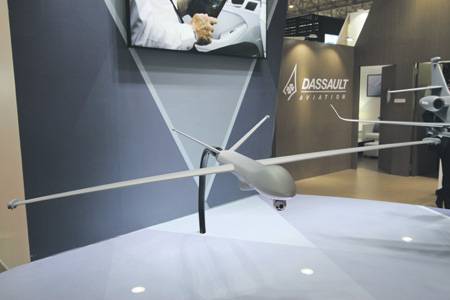Battle of the drone market
 The Dubai Airshow 2017, recently completed in the suburbs of Dubai, has traditionally become a venue for exhibiting not only a multitude of manned, but also unmanned aviation systems of various classes and types. At the same time, one of the central trends that emerged at this exhibition was the abundance of demonstrated samples of unmanned aerial vehicles (UAVs) of the MALE class (Medium Altitude Long Endurance - a class of medium-altitude drones with long flight times).
The Dubai Airshow 2017, recently completed in the suburbs of Dubai, has traditionally become a venue for exhibiting not only a multitude of manned, but also unmanned aviation systems of various classes and types. At the same time, one of the central trends that emerged at this exhibition was the abundance of demonstrated samples of unmanned aerial vehicles (UAVs) of the MALE class (Medium Altitude Long Endurance - a class of medium-altitude drones with long flight times).Vehicles of this dimension are capable of carrying on board weapon, which is a very attractive option for the armed forces of many countries in addition to the capabilities of conducting reconnaissance and surveillance using optical-electronic and radar equipment.
However, the American Predator XP (Predator XP) UAV, which is a simplified export version of the MQ-1 multi-purpose UAV used by the US military, is devoid of weapons. These systems have already been sold in the UAE. The corresponding contract for the supply of an unnamed number of UAVs with a total value of about 197 million was signed in 2013. Perhaps that is why at the current salon the device was presented only in the form of a reduced model at the booth of the developer company General Atomics.
The device is almost completely consistent with the basic version of the UAV - it has similar dimensions, speed, maximum flight duration and practical ceiling. The drone can fly at distances up to 740 km, carrying a payload of a total weight of up to the order of 200 kg on board.
At the same time, the simplifications carried out in terms of its subsystems led to a certain decrease in the cost of the complex as a whole. It is reported that it can be used both in military tasks, for reconnaissance and surveillance, and in civilian - aerial surveys and mapping, security monitoring, environmental studies, etc.
CHINA ROLES IN LEADERS
 The success of the United States in this segment of unmanned aircraft systems did not leave indifferent developers from other countries who, in addition to solving the task of equipping their own armed forces, obviously have a desire to receive revenues from external supplies. The leading role is played by the PRC. Three unmanned aerial vehicles of the appropriate class were shown on the static platform of the Dubai cabin: Wing Loong I (Wing Loong I), also known as Pterodactyl Pterodactyl; "Wing Loong" II (Wing Loong II) and "Cloud Shadow" (Cloud Shadow).
The success of the United States in this segment of unmanned aircraft systems did not leave indifferent developers from other countries who, in addition to solving the task of equipping their own armed forces, obviously have a desire to receive revenues from external supplies. The leading role is played by the PRC. Three unmanned aerial vehicles of the appropriate class were shown on the static platform of the Dubai cabin: Wing Loong I (Wing Loong I), also known as Pterodactyl Pterodactyl; "Wing Loong" II (Wing Loong II) and "Cloud Shadow" (Cloud Shadow).Vin Lun I is an unmanned aerial vehicle with an take-off mass of the order of 1,1 t. The drone equipped with a turboprop engine can rise to an altitude of 6000 m. The maximum flight duration is 20 hours, the range of action over the radio channel is 200 km. The “Vin Lun” I UAV lifts the payload 200 kg, of which half is on external hangers. It can be a multichannel optoelectronic surveillance system and a synthetic aperture radar, as well as a variety of weapons systems, including AKD-10 anti-tank guided missiles and FT-7 / 130 planning bombs.
The project was launched in 2005, and already in 2007, the first flight took place. The layout of the drone was first shown to the public in 2008 at the aviation exhibition in Zhuhai, China. It is known that the Vin Loon I UAVs are used by the PLA, and in 2015, they even appeared at the parade in Beijing. The Chinese government has approved the export of these systems. At the moment, in addition to the UAE, as is known, this UAV has been delivered to Egypt, Nigeria and Uzbekistan.
The heavier Vin Loon II UAV, created in the development of the previous model, has a maximum take-off mass of about 4200 kg. According to the developer, the flight duration of the Vin Loon II drone is the same 20 hours, the ceiling is slightly more than 9000 m. It is known that the drone is equipped with an on-board optical-electronic reconnaissance and surveillance system and a synthetic aperture radar, capable of carrying radio engineering equipment ( RTR) and electronic warfare (EW), as well as data relay systems. In addition, the UAV solves the impact tasks - high-precision weapons with a total weight of up to 480 kg are placed on six points of the suspension, including up to 12 air-to-surface missiles, FT-9 / 50, TL-10 bombs, and laser bombs GB3 homing head.
The third of the presented Chinese unmanned aerial vehicles, the “Cloud Shadow”, is somewhat lighter than the “Vin Lung” II - its maximum take-off weight is about 3200 kg. In contrast to the “Pterodactyls”, it uses a turbojet engine as a power plant, which allows it to achieve great performance in flight speed. Its maximum speed is 620 km / h, cruising - 420 km / h. The maximum flight duration is 6 hours. The range of the UAV over the radio channel is up to 290 km. The effective range of the UAV is about 2000 km.
The Cloud Shadow UAV can also be used in reconnaissance and reconnaissance-strike configurations. The total mass of the payload drone reaches 400 kg. Under each wing of the wing there are three points of suspension for various means of destruction, for which various bombs are currently being offered, including Blue Arrow 7 (Blue Arrow 7), Blue Arrow 21, AG-300M and YJ-9Е, and also air-to-surface guided missiles.
ANKARA GOES THE TRACE
The Turkish presence in the field of unmanned aircraft systems at the Dubai exhibition was marked with two MALE-class devices - “Anka” (Anka) and “Karael” (full name Karayel-SU). The first is represented by a valid sample, the second by a full-size mockup.
"Anka" (Anka, the name given by the name of the magic bird of the same name, which is also often called Simurg) is a reconnaissance-impact drone created by Turkish Aerospace Industries (TAI). The device has a maximum take-off weight of about 1600 kg. The Thielert Centurion engine is used as a power plant, allowing the UAV to fly for up to 24 hours at altitudes up to 9000. The UAV is equipped with an electropulse anti-icing system, the elements of which are located in the wing consoles and tail assembly.
 The AselFLIR-300T AselFLIR-XNUMXT optoelectronic surveillance system, as well as synthetic aperture radar, is installed as a payload on the UAV. As weapons on the UAV can be installed missiles "Dzhirit" (Cirit, translated from Turkish - spear or dart) development company Roketsan.
The AselFLIR-300T AselFLIR-XNUMXT optoelectronic surveillance system, as well as synthetic aperture radar, is installed as a payload on the UAV. As weapons on the UAV can be installed missiles "Dzhirit" (Cirit, translated from Turkish - spear or dart) development company Roketsan.The contract for the development of this system under the TUAV program was signed by the Ministry of Defense of Turkey with TAI in 2004. The first public demonstration of the Anka UAV took place at an air show in the British Farnborough in 2010, at the end of the same year the first flight was performed. It is known that these UAVs are already being exploited in the Turkish Armed Forces. A few years ago it was reported that there were agreements for the supply of a UAV lot to Egypt, but nothing is known about the fact of the implementation of this delivery.
The second of the mentioned Turkish drones - "Karael" developed by Vestel Defense. This modification was first shown to the general public at the Dubai Air Show this year. As far as we know, after the first public demonstration of the Karael BLA prototype, the company continued to work on creating an armed version of this drone under the designation “S-variant”. His first trials began in the 2016 year.
According to reports, in the new modification, the drone received a wing of increased magnitude. The payload mass increased from 120 to 170 kg. According to the developers, the drone can be in the air up to 20 hours and rise to an altitude of up to 5,5 km. Under each wing of the wing there are two weapon suspension points, where the high-precision MAM-L and MAM-C bombs developed by Roketsan can be installed.
Nothing is known about the potential interested customers of this system. However, it is obvious that the company would like to use the market of the Gulf countries and the Middle East as a whole as a platform for expanding the sales of unmanned systems created.
GUEST FROM ER-RIYADA
It is curious that the UAE’s Saudi Arabia neighbors of the United Arab Emirates presented their MALE UAV project at the Dubai Airshow, which, according to available data, previously signed a contract to organize licensed production in the country of the Pterodactyl (Vin Lun) family unmanned aerial vehicles. The cost of the contract, along with related equipment and weapons, according to media reports, was about 10 billion dollars, which made it the largest contract for the purchase of UAVs. Nevertheless, own developments in this area are also conducted here.
Work on the creation of an unmanned aerial vehicle "Sakr-1" (Saqr 1) is the Scientific and Technological Center named after King Abdulaziz (KACST - King Abdulaziz City for Science and Technology). The flight range of this UAV exceeds 2500 km. The cruising altitude of the vehicle is 6000 m, the flight duration is about 24 h. The UAV is equipped with a Ka-band satellite communication system, which expands the possibilities of its use. As a combat load, the drone can carry missiles and bombs with a laser guidance system.
EUROPE DOES NOT LACK
A reduced model of the Patroller was presented at the stand of France. The UAV was created by Sagem together with the German Stemme. This unit is one of the most striking examples of creating a UAV not from scratch as an independent product, but on the basis of an existing manned vehicle - it is based on the Stemme ASP S-15 glider.
The UAV can be used for reconnaissance purposes, adjusting artillery fire, etc. The range of the UAV is 250 km. According to official data, the UAV can fly for up to 20 hours. The maximum flight height is 6000 m. The device can carry a payload with a total weight of more than 250 kg as a multi-touch surveillance system on the Sagem Euroflir XRUMX gyro-stabilized platform. In addition, this unmanned aerial vehicle is equipped with a radar system.
Work on the project began in 2008. In 2009, a prototype UAV was shown at the Paris Air Show at Le Bourget. Later work was continued. The first flight of the drone took place in 2012 year. The successful completion of flight tests, according to available data, allowed to begin mass production of this system.
Austrian company Diamond Aircraft has brought a DA-42 aircraft to the exhibition, which can be used for patrol purposes, including the unmanned version, as is the case with the Patroller. Aircraft body is made of carbon-based composite materials. The maximum take-off weight of the device is slightly more than 1700 kg, including the payload - up to 532 kg. He made his first flight in 2002. This is the first diesel-powered aircraft that flew across the Atlantic Ocean (from Canada to Portugal), for which it spent 28 hours. The aircraft received a certificate in May 2004. The experience of creating an unmanned version based on this aircraft had, in particular, the Israeli company Aeronautics Defense Systems. In addition, Russian developers had plans to use DA-42 to build an unmanned vehicle on its base.
The Italian company Leonardo (formerly Finmeccanica), which previously periodically displayed its promising Sky-Y (Sky-Y) drone at international exhibitions, this year brought only tactical systems to Dubai. The European presence in the field of MALE UAVs was also marked by the appearance of a diminished model of a promising pan-European UAV. However, the creation of this system is obviously a matter of a fairly distant future.
PICTURE CHANGED RADICALLY
A few years ago, the picture with unmanned aircraft systems demonstrated at the Dubai cabin was somewhat different. A substantial part of the unmanned aerial vehicles that were represented were a variety of tactical-class devices. Currently, tactical drones to a significant extent have given way to medium-altitude vehicles of long duration.
The advantages provided by the devices of this class in the form of the possibility of carrying more high-quality and diverse surveillance systems, as well as the carrying of weapons, the ability to perform long flights lasting several dozen hours, etc. in the eyes of potential customers, the disadvantages in the form of the need for high-quality aerodrome runways, higher acquisition and ownership costs obviously outweigh.
American developers active exploitation of the drones in the military conflicts of the last decade have managed to create an image of high-performance military systems of the future. Meanwhile, the “Predators” remained for a long time a weapon for the elect, due to export restrictions, they were available only to a narrow circle of countries from among the closest allies of the United States. However, demand creates supply. Chinese, Asian and other developers have shown that, albeit with some delay, they are ready to meet the demand of solvent customers. Is there a place in this market for Russia? While there. But the window of opportunity as the market becomes saturated will gradually close, and competition will grow.
Information